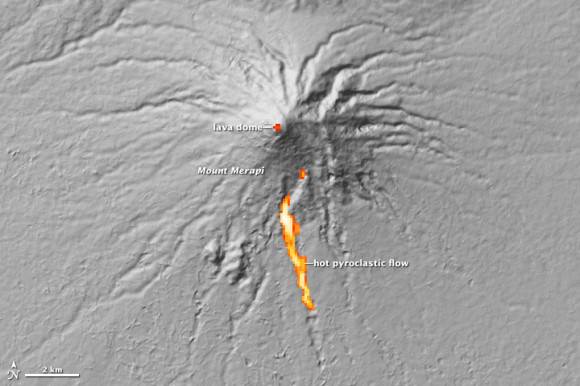[/caption]
For about three weeks, Indonesia’s Mount Merapi has been belching out lava, as well as ash and gas, clouding the atmosphere above. This satellite image, taken by NASA’s MODIS instrument on the Terra satellite, shows the volcano now settling down and is the most cloud-free satellite view of the volcano that we’ve been able to see. Thick ash is still rising and the volcano is still considered to be erupting at dangerous levels. Merapi is one of Indonesia’s most active volcanoes, and this eruption has been the most violent since the 1870’s.
The dark brown streak down the southern face of the volcano is ash and other volcanic material deposited by a pyroclastic flow or lahar. The volcano has been blamed for 156 deaths and about 200,000 people had to evacuate. The ash also caused flights to be delayed or canceled.
See below for a thermal image of the lava flow.

As a very active volcano, Merapi poses a constant threat to thousands of people in Indonesia. The Advanced Spaceborne Thermal Emission and Reflection Radiometer (ASTER) on NASA’s Terra satellite captured the thermal signature of hot ash and rock and a glowing lava dome. The thermal data is overlaid on a three-dimensional map of the volcano to show the approximate location of the flow. The three-dimensional data is from a global topographic model created using ASTER stereo observations.
For more information see NASA’s Earth Observatory website.


Maybe the volcanic plume will give a small temporary reversal to the global warming.
LC
I hope this volcano doesn’t get as powerful as a Tambora type eruption that cool the Earth for a few years causing year ‘without a Summer’ in various areas
A Tabora type eruption will be horrendous to areas near the volcano.
I’m curious if this eruption may visibly alter the appearance of the fully eclipsed moon on Dec 20-21. Already ash from Merapi is predicted to produce colorful extended twilight in parts of Australia. While Merapi may be no Pinatubo (in terms of total ash ejection into the troposphere), its current emissions may lead to a visibly darker eclipsed moon or present peculiar color variations in the umbra or penumbra. So anyone who plans to take a peek (or image) the upcoming lunar eclipse may want to keep this possibility in mind.
[For North American viewers, this will be the last total eclipse of the moon until April 14-15, 2014!]
“I hope this volcano doesn’t get as powerful as a Tambora type eruption that cool the Earth for a few years causing year ‘without a Summer’ in various areas
A Tabora type eruption will be horrendous to areas near the volcano.”
Unfortunately, Indonesia is home to some of the most notorious volcanoes in history – Krakatau, Toba, Agung and Tambora: http://en.wikipedia.org/wiki/List_of_volcanoes_in_Indonesia#Major_eruptions
The eruption of Toba 74,000 years ago would have been a bad day for more than just (prehistoric) Indonesians.
*JON HANFORD- Thank you for the link. People in the US worry about Yellowstone Volcano, but I figure it would take about 50 years of rumbling,shaking, erupting before the superblast begins. This Toba total ejecta is larger than than largest Yellowstone super-eruptions. Yoowwwww,
Last August 2009, I visited the peak of Mt. Merapi, but from Northern side; that hot pyroclastic flow is at southern part. I felt the peak was like at Mars 🙂
This volcano is currently not producing lots of ash. Its crater is blocked up by solidified hot lava which is being slowly pushed up the chimney by high pressure from hot gas from below. This forms a protroding lava dome, parts of which break down in avalanches by and by, creating pyroclastic flows down the valleys.
There is some chance that Merapi may explode, like Mount St. Helens or the Pinatubo, but we don´t know yet. With its current rate of ash production, Merapi won´t have an effect on the december lunar eclipse.
I think this eruption is gonna have a long term impact on the climate of Earth.
illumibriter